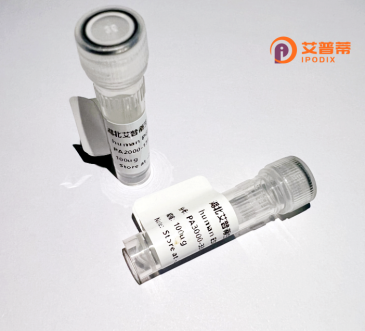
| 纯度 | >90%SDS-PAGE. |
| 种属 | Human |
| 靶点 | MYOD1 |
| Uniprot No | P15172 |
| 内毒素 | < 0.01EU/μg |
| 表达宿主 | E.coli |
| 表达区间 | 1-320 aa |
| 活性数据 | MELLSPPLRD VDLTAPDGSL CSFATTDDFY DDPCFDSPDL RFFEDLDPRL MHVGALLKPE EHSHFPAAVH PAPGAREDEH VRAPSGHHQA GRCLLWACKA CKRKTTNADR RKAATMRERR RLSKVNEAFE TLKRCTSSNP NQRLPKVEIL RNAIRYIEGL QALLRDQDAA PPGAAAAFYA PGPLPPGRGG EHYSGDSDAS SPRSNCSDGM MDYSGPPSGA RRRNCYEGAY YNEAPSEPRP GKSAAVSSLD CLSSIVERIS TESPAAPALL LADVPSESPP RRQEAAAPSE GESSGDPTQS PDAAPQCPAG ANPNPIYQVL |
| 分子量 | 34.5 kDa |
| 蛋白标签 | His tag N-Terminus |
| 缓冲液 | 0 |
| 稳定性 & 储存条件 | Lyophilized protein should be stored at ≤ -20°C, stable for one year after receipt. Reconstituted protein solution can be stored at 2-8°C for 2-7 days. Aliquots of reconstituted samples are stable at ≤ -20°C for 3 months. |
| 复溶 | Always centrifuge tubes before opening.Do not mix by vortex or pipetting. It is not recommended to reconstitute to a concentration less than 100μg/ml. Dissolve the lyophilized protein in distilled water. Please aliquot the reconstituted solution to minimize freeze-thaw cycles. |
以下是关于重组人MYOD1蛋白的3篇参考文献的简要信息:
1. **文献名称**:Induction of Skeletal Myogenesis by Recombinant Human MYOD1 Protein in Embryonic Fibroblasts
**作者**:Weintraub, H., et al.
**摘要**:该研究首次证实重组表达的MYOD1蛋白可直接诱导胚胎成纤维细胞分化为肌源性细胞,揭示了其作为主调控因子在跨细胞类型中的功能活性。
2. **文献名称**:Structural Basis of MYOD1 DNA Binding Domain Dimerization Revealed by Crystallographic Analysis
**作者**:Tapscott, S.J., et al.
**摘要**:通过X射线晶体学解析了重组人MYOD1蛋白的DNA结合域结构,阐明其二聚化机制及与靶基因启动子结合的分子基础。
3. **文献名称**:Enhancement of Skeletal Muscle Regeneration by Recombinant MYOD1-Loaded Nanoparticles in a Murine Injury Model
**作者**:Kuang, S., et al.
**摘要**:开发了一种搭载重组MYOD1蛋白的纳米颗粒递送系统,证明其在肌肉损伤模型中促进卫星细胞活化和组织再生,具有治疗潜力。
MYOD1 (myogenic differentiation 1) is a pivotal transcription factor central to skeletal muscle development and cellular reprogramming. As a member of the myogenic regulatory factor (MRF) family, it orchestrates the transcriptional activation of muscle-specific genes by binding to E-box DNA motifs through its basic helix-loop-helix (bHLH) domain. Initially identified for its role in converting fibroblasts into myoblasts, MYOD1 serves as a master regulator of myogenesis, initiating cell cycle exit and activating downstream targets like myogenin and muscle creatine kinase.
Recombinant MYOD1 protein is produced using expression systems such as *E. coli* or mammalian cells, often fused with tags (e.g., His-tag) for purification via affinity chromatography. Its engineered form retains the functional bHLH domain, enabling studies on myogenic differentiation mechanisms without viral transduction. Researchers utilize it to investigate muscle regeneration, disease models (e.g., muscular dystrophy), and direct reprogramming of non-muscle cells into myogenic lineages. In therapeutic contexts, MYOD1-based strategies are explored for muscle wasting disorders, though challenges in delivery efficiency and off-target effects persist. Biochemical assays (e.g., electrophoretic mobility shift) confirm its DNA-binding activity, while cell culture models validate its capacity to induce myotube formation. As a tool, recombinant MYOD1 bridges developmental biology and regenerative medicine, offering insights into transcriptional control and cell fate manipulation.
×